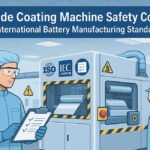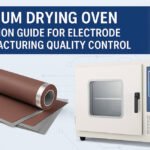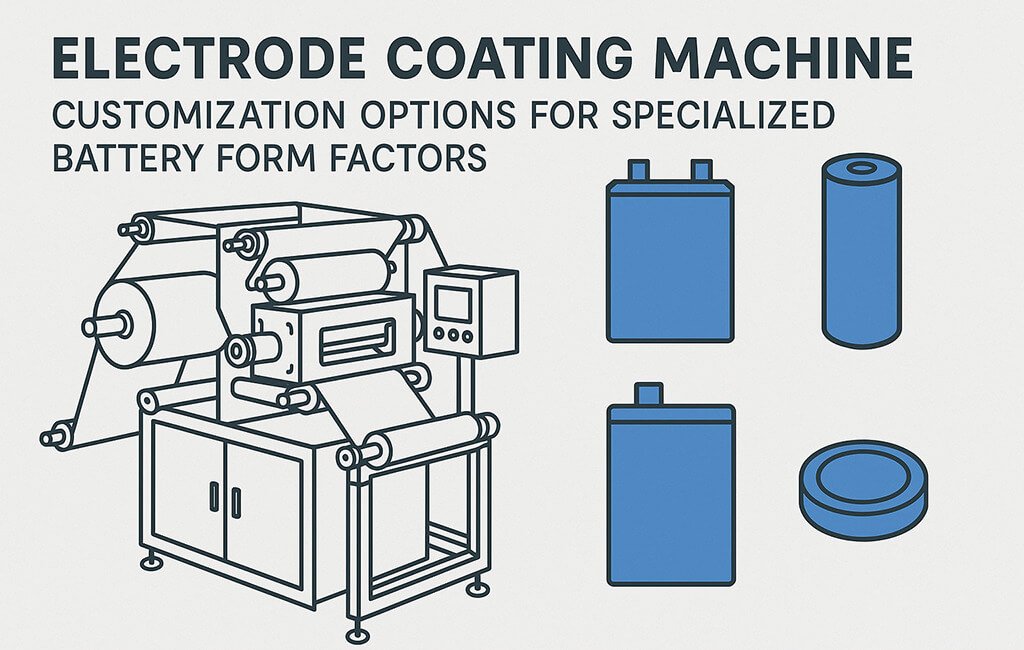What Critical Customization Factors Do Competitors Overlook?
Most industry analyses focus on market trends and generic equipment specifications. However, they fail to address the practical engineering challenges of adapting coating systems for specialized batteries. Our analysis reveals three critical oversights that impact real-world production.
| Competitor Coverage | What They Missed | Real-World Impact |
|---|---|---|
| Generic slot-die specifications (±3μm accuracy) | Form factor-specific die lip configurations | 20–30% yield loss when coating thick electrodes (>200μm) for energy storage |
| Standard width ranges (100–650mm) | Edge bead control customization for pouch cells | 5–8mm material waste per edge without proper customization |
| Fixed drying zone temperatures | Multi-zone thermal profiling for varying thicknesses | 15% capacity fade in cells with improper solvent removal |
How Do Coating Width Configurations Impact Different Battery Form Factors?
The electrode coating machine width configuration represents the most fundamental customization decision. This choice directly affects material utilization and downstream processing efficiency. Different battery form factors require specific width adaptations for optimal performance.
Pouch Cell Coating Customization
Automotive pouch cells require 200–400mm electrode widths with precise control systems. These larger formats demand specialized equipment features to maintain quality and efficiency.
- Dual-edge thickness control systems: Pneumatic or servo-driven edge guides maintaining ±0.5mm positioning accuracy to prevent stacking misalignment
- Intermittent coating capability: Pattern coating modules for tab areas, reducing post-coating cleaning from 3 minutes to 15 seconds per batch
- Wide-format tension control: Multi-zone tension systems (typically 5–7 zones) preventing web wander beyond 1mm/m
Cylindrical Cell Adaptations
18650 and 21700 cells demand narrower, high-precision coating configurations. These formats prioritize speed and accuracy over width.
- Narrow web handling: 50–100mm coating widths with enhanced edge quality control
- High-speed capability: Line speeds up to 120m/min versus 40–60m/min for pouch cells
- Rapid width changeover: Cassette-style die systems enabling 30-minute format changes
Specialty Form Factor Requirements
Medical and military batteries present unique challenges requiring ultra-precise coating systems. Contamination control and traceability become critical factors.
- Ultra-narrow coating: 10–30mm widths with ±0.1mm tolerance
- Contamination prevention: HEPA-filtered coating enclosures maintaining ISO Class 7 conditions
- Batch traceability: Laser marking systems integrated with coating parameters
What Coating Thickness Control Mechanisms Enable Multi-Chemistry Production?
Modern battery facilities increasingly demand electrode coating machines capable of handling multiple chemistries. Single production lines must accommodate different loading levels without extensive downtime. This flexibility requires sophisticated thickness control mechanisms.
Die Lip Customization Options
Leading equipment manufacturers like Toray Engineering and Hirano Tecseed offer modular die designs. These systems adapt to different chemistry requirements through interchangeable components.
| Chemistry Type | Typical Loading | Die Gap Range | Customization Features |
|---|---|---|---|
| LFP (Energy Storage) | 25–35 mg/cm² | 200–400 μm | Carbide-lined lips, thermal expansion compensation |
| NMC (Automotive) | 15–25 mg/cm² | 100–250 μm | Quick-change shim sets, ultrasonic cleaning ports |
| LTO (Fast Charge) | 10–15 mg/cm² | 50–150 μm | Precision ground lips, ±1μm adjustment resolution |
Real-Time Thickness Monitoring Integration
Standard machines rely on post-coating measurement, which limits quality control effectiveness. Customized systems incorporate advanced monitoring technologies for immediate feedback and adjustment.
- In-line beta ray sensors: Mahlo or Micro-Epsilon systems providing ±0.5% accuracy at 10mm spatial resolution
- Closed-loop die adjustment: Servo-actuated die bolts responding to thickness variations within 2 seconds
- Predictive coating models: Machine learning algorithms compensating for slurry rheology changes
Consider reading our guide on electrode slurry preparation techniques for optimal coating results.
How Do Drying System Customizations Address Thick Electrode Challenges?
Energy storage applications push electrode thicknesses beyond 200μm, requiring fundamental changes to drying systems. Standard configurations cannot adequately remove solvents from these thick coatings. Proper drying customization prevents defects and ensures cell performance.
Multi-Zone Temperature Profiling
Customized drying systems for thick electrodes use progressive temperature control. Each zone targets specific evaporation stages to prevent surface defects.
- Progressive temperature zones: 60°C → 90°C → 120°C → 100°C profile preventing surface skinning
- Variable air velocity control: 0.5–5 m/s adjustable per zone based on solvent evaporation rate
- Infrared augmentation: Medium-wave IR emitters targeting 3–4μm absorption peak of NMP
Residence Time Flexibility
Standard 10–15m ovens prove insufficient for thick electrodes. Extended drying sections ensure complete solvent removal without damaging the coating.
- Modular oven extensions: 5m increments allowing 20–40m total length
- Variable speed drives: 0.5–50 m/min range versus typical 5–30 m/min
- Accumulator systems: Buffering web during speed transitions
What Competitors Missed: Form Factor Transition Capabilities
Existing content overlooks the practical challenges of transitioning between form factors. Contract manufacturers and pilot facilities face this challenge daily. Efficient changeover capabilities determine overall equipment effectiveness.
Rapid Changeover Engineering
State-of-the-art electrode coating machine customization prioritizes quick transitions. Modern systems reduce downtime through intelligent design and automation.
- Cassette-based coating heads: Pre-aligned die assemblies reducing changeover from 4 hours to 45 minutes
- Automated width adjustment: Servo-driven edge guides with position memory for recurring products
- Recipe management systems: Storing complete parameter sets including tension, temperature, and speed profiles
Cross-Contamination Prevention
Switching between incompatible chemistries requires careful contamination control. LFP to NMC transitions, for example, demand thorough cleaning protocols. Customized systems automate these processes for consistency.
- Automated cleaning cycles: Programmable solvent flush sequences with waste segregation
- Removable contact components: Quick-disconnect backup rolls and coating lips
- Material tracking barriers: Physical and software interlocks preventing chemistry mixing
How Do Substrate Handling Customizations Enable Alternative Current Collectors?
While competitors focus solely on aluminum and copper foils, emerging applications demand coating on alternative substrates. Next-generation batteries require equipment capable of handling diverse materials. These substrates present unique handling challenges.
Ultra-Thin Foil Handling
Thinner current collectors improve energy density but require gentle handling. Standard equipment often damages 6μm aluminum or 4μm copper foils.
- Air-turn bars: Non-contact web guidance preventing microscopic scratches
- Reduced tension operation: 0.1–0.3 N/cm versus standard 0.5–1.0 N/cm
- Static elimination systems: Dual-polarity ionizers preventing foil adhesion
Polymer Substrate Adaptations
Solid-state battery development uses polymer substrates with different properties than metal foils. These materials require specialized handling systems.
- Temperature-compensated tension control: Accounting for 10× higher thermal expansion
- Corona treatment integration: In-line surface activation for coating adhesion
- UV-curing capability: Alternative to thermal drying for heat-sensitive materials
Learn more about current collector innovations in our technical library.
What Quality Control Integrations Distinguish Customized Systems?
Basic coating thickness measurement no longer suffices for specialized battery production. Comprehensive quality monitoring catches defects before they impact cell performance. Modern systems integrate multiple inspection technologies.
Vision System Customization
Advanced electrode coating machines incorporate inspection at multiple points. Each inspection type targets specific defect modes that affect battery performance.
| Inspection Type | Standard Capability | Customization Options | Defect Detection Impact |
|---|---|---|---|
| Surface defects | 5mm resolution | 0.1mm with telecentric lenses | Catches 95% of pinholes >0.2mm |
| Edge quality | Visual inspection | Laser profilometry ±5μm | Reduces cell shorts by 60% |
| Coating uniformity | Spot checks | Full-width thermal imaging | Identifies 98% of thickness variations |
Data Integration Architecture
Quality data becomes valuable only when properly collected and analyzed. Customized systems enable comprehensive data management.
- MES connectivity: Real-time parameter upload to Siemens Opcenter or similar
- Predictive maintenance alerts: Vibration and temperature monitoring of critical components
- Batch genealogy tracking: Complete parameter history for root cause analysis
How Do Modular Designs Enable Future Form Factor Flexibility?
Fixed-configuration equipment limits future production options. Modular customization protects capital investments by enabling adaptation to new battery designs. This flexibility becomes crucial as battery technology evolves.
Mechanical Modularity
Leading manufacturers structure machines for easy modification. Common frames accept different coating technologies and configurations.
- Interchangeable coating stations: Slot-die, comma bar, and gravure options on common frames
- Expandable drying sections: Pre-engineered connection points for length extensions
- Universal unwind/rewind systems: Accommodating 200–800mm diameter rolls without major modification
Control System Flexibility
Software customization enables rapid adaptation to new requirements. Open architectures allow custom programming for unique processes.
- Open architecture PLCs: Siemens S7-1500 or Beckhoff TwinCAT allowing custom function blocks
- Modbus/OPC-UA connectivity: Integration with third-party inspection or measurement systems
- Remote access capability: Secure VPN connections for off-site troubleshooting
What Cost-Performance Trade-offs Define Optimal Customization Levels?
Practical customization decisions require specific cost-benefit analysis beyond vague ROI discussions. Each customization level suits different production scenarios. Understanding these trade-offs prevents over-engineering or under-specifying equipment.
Customization Investment Tiers
Different production requirements justify different customization levels. This table helps determine appropriate investment levels.
| Customization Level | Typical Investment Premium | Payback Scenario | Best Application |
|---|---|---|---|
| Basic (width/speed adjustment) | 10–15% over standard | Single product >1M cells/month | Dedicated EV cell production |
| Moderate (chemistry flexibility) | 25–35% over standard | 3–5 products, 500k cells/month each | Contract manufacturers |
| Advanced (full modularity) | 50–70% over standard | R&D + pilot production | Battery development centers |
Hidden Cost Considerations
Initial equipment cost represents only part of the total investment. Proper planning must account for operational expenses.
- Validation complexity: Each configuration requires 50–200 hours of qualification runs
- Spare parts inventory: 20–30% higher for multi-configuration systems
- Operator training: 2–3× longer for highly customized equipment
Implementation Case Study: Multi-Format Contract Manufacturing Facility
A tier-2 battery manufacturer successfully implemented a highly customized electrode coating machine to serve diverse customers. This real-world example demonstrates the practical benefits of thoughtful customization. The results validate the investment in flexible equipment.
Initial Requirements
The facility needed to produce multiple battery types on a single line. Customer demands varied significantly across form factors and chemistries.
- Pouch cells: 200–300mm width, 15–25 mg/cm² loading
- Cylindrical cells: 65mm width, 18–22 mg/cm² loading
- Specialty medical: 30mm width, 10–12 mg/cm² loading
- Chemistry variations: LFP, NMC622, NMC811
Customization Implementation
Working with equipment supplier Toray Engineering, the facility integrated multiple advanced features. Each customization addressed specific production challenges.
- Triple cassette coating head system: Pre-configured dies for each product family
- Variable width slitting integration: In-line slitting from 300mm to final widths
- Flexible drying system: 25m length with 5 independently controlled zones
- Comprehensive inspection suite: Beta ray thickness, vision inspection, and laser profilometry
Operational Results
The customized system delivered significant improvements across all metrics. These results justified the additional investment in flexibility.
- Changeover time: Reduced from 8 hours to 1.5 hours between major format changes
- First-pass yield: Improved from 87% to 94% through optimized parameters
- Capacity utilization: Increased from 65% to 82% by eliminating dedicated lines
Conclusion: Engineering the Future of Flexible Battery Production
The evolution toward specialized battery form factors demands a fundamental shift in electrode coating machine customization approaches. Surface-level market analyses fail to address the engineering complexities of flexible production. Successful implementation requires deep understanding of technical trade-offs.
The most successful customization strategies balance three critical factors. Technical requirements of diverse form factors must align with operational realities of multi-product manufacturing. Economic constraints of capital investment set practical boundaries for customization levels.
Manufacturers can build adaptive coating systems by focusing on modular designs, comprehensive quality integration, and rapid changeover capabilities. These systems meet current production needs while preparing for future battery innovations. The engineering frameworks outlined in this guide provide the foundation for informed customization decisions.
As battery applications continue diversifying, production flexibility becomes increasingly critical. From micro-batteries for medical implants to massive cells for grid storage, coating equipment must adapt. The ability to customize electrode coating equipment will separate market leaders from those constrained by inflexible production assets.



